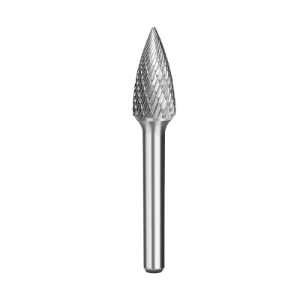Carbide Rotary Burs are widely used in various industries for precision cutting, grinding, and shaping of hard materials. Known for their durability and sharpness, these tools offer good performance compared to traditional burs. However, improving the cutting efficiency of carbide rotary burs requires attention to multiple factors, including tool selection, operational parameters, and maintenance. This article discusses practical ways to enhance the cutting efficiency of carbide rotary burs to achieve better productivity and longer tool life.

Selecting the Right Carbide Rotary Burs for the Task
One of the steps to improve cutting efficiency is selecting the appropriate carbide rotary burs designed for the specific material and application. Different burs vary in shape, flute design, and grit size, which affect their cutting action and chip removal capabilities. For instance, coarse-grit burs are better for rapid material removal, while fine-grit burs provide smoother finishes. Additionally, the geometry of the bur teeth—such as single-cut or double-cut patterns—affects cutting aggressiveness and surface quality. Matching the right bur to the workpiece ensures efficient cutting and reduces unnecessary wear.
Optimizing Cutting Speed and Feed Rate
Operating parameters like cutting speed (RPM) and feed rate significantly impact the performance of carbide rotary burs. Running the bur at too low a speed may cause inefficient cutting and tool clogging, while excessively high speeds can cause overheating and premature wear. Manufacturers often provide recommended speed ranges for specific burs and materials, which should be closely followed. Similarly, the feed rate—how fast the bur engages the material—should be optimized to balance material removal rate and tool life. Using variable-speed rotary tools or CNC machines with programmable parameters allows fine-tuning of these settings for suitable efficiency.
Ensuring Proper Cooling and Lubrication
Heat generation during cutting is a major factor that reduces the efficiency and lifespan of carbide rotary burs. Excessive heat can soften the carbide, dull cutting edges, and cause thermal damage to both the tool and the workpiece. Applying appropriate cooling and lubrication helps dissipate heat, reduce friction, and flush away chips from the cutting area. Options include compressed air, mist cooling, or flood coolant systems, depending on the machining environment. Proper cooling not only improves cutting efficiency but also maintains the bur’s sharpness for longer durations.
Maintaining and Replacing Carbide Rotary Burs Timely
Regular inspection and maintenance of carbide rotary burs play a crucial role in sustaining cutting efficiency. Over time, burs can become dull, chipped, or clogged with debris, all of which decrease cutting performance. Cleaning burs after each use to remove built-up material and inspecting for signs of wear allows timely intervention. Using dressing tools to sharpen burs, if applicable, can restore cutting edges. When burs are excessively worn or damaged, prompt replacement is necessary to avoid compromising efficiency and surface quality. Keeping an inventory of quality burs also prevents downtime during production.
Training Operators for Suitable Use
Finally, the skill and knowledge of the operator influence how well carbide rotary burs perform. Proper handling, avoiding excessive pressure, and following recommended operational guidelines reduce tool stress and improve cutting consistency. Training operators on the correct use, speed settings, and maintenance routines ensures that carbide rotary burs are used to their full potential. Additionally, experienced operators can identify early signs of tool wear and adjust processes to maintain efficiency.